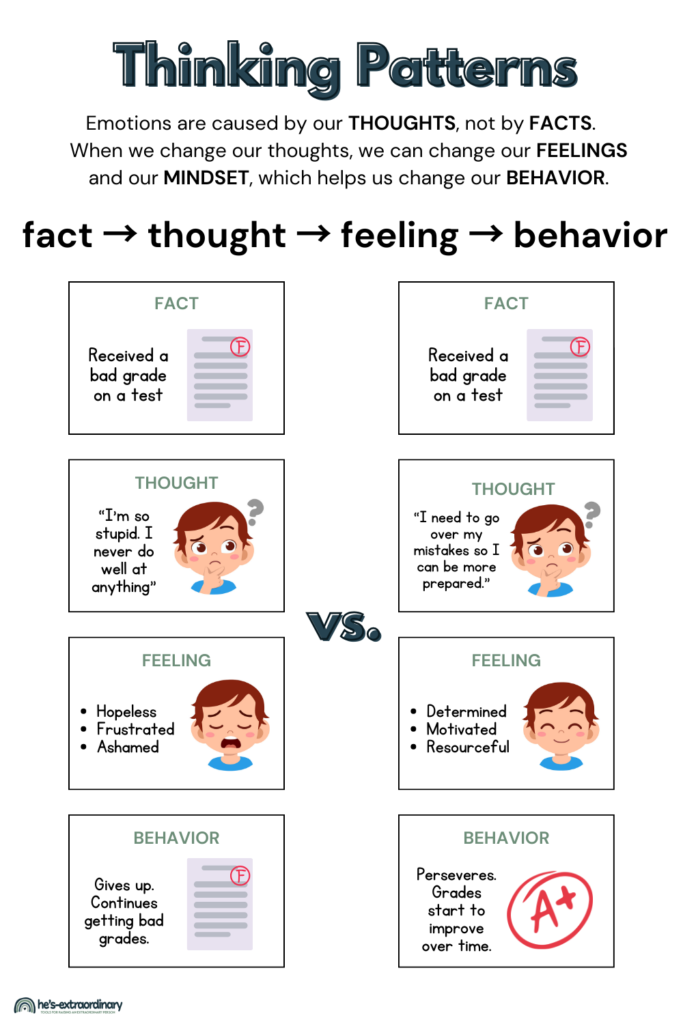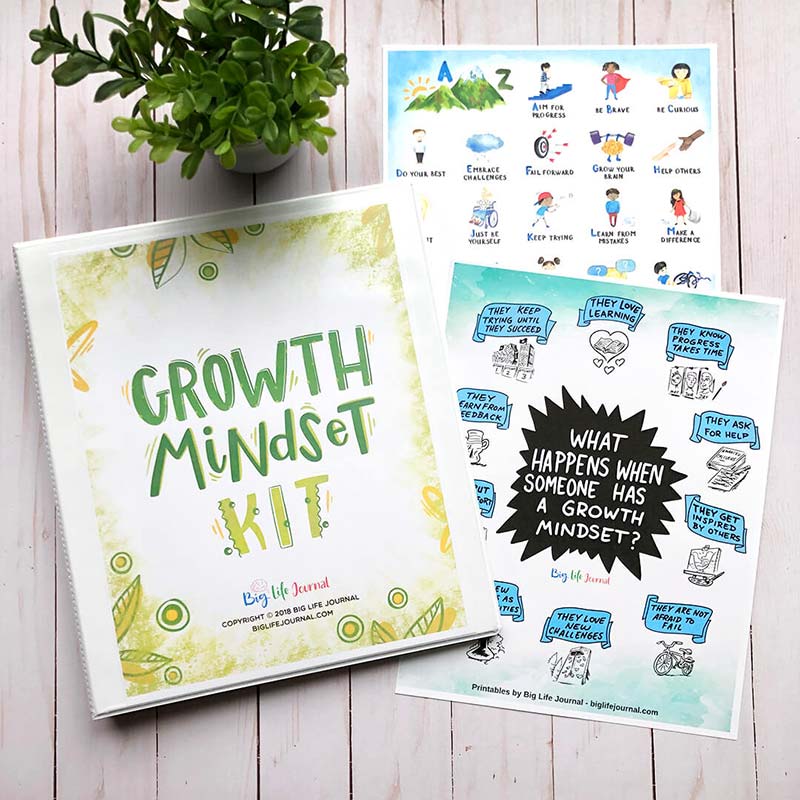Negative Thinking Patterns That are Giving Your Child Anxiety
What’s inside this article: Six forms of negative thinking patterns that contribute to anxiety in kids with examples to help you recognize these thinking patterns and strategies that help children reframe their thoughts and develop a positive mindset.
Disclaimer: This post contains affiliate links.
Note: Everyone has some anxiety. It’s a normal and necessary human emotion. If you’re not sure whether or not your child is experiencing a normal level of anxiety, take a moment to read these warning signs of anxiety disorders in preteens and teens.
Psychologists know that our emotions come directly from our thoughts, not from the facts or events that triggered those thoughts.
Although this whole process happens spontaneously, meaning it can be hard to differentiate our thoughts and feelings from the facts.
This is even more challenging for children and falling into patterns of negative thinking contributes to mental health challenges like anxiety.

Thinking about the boy in the example above – if he continues to have negative thought patterns like the one on the left – as future tests and assignments come up, he may start to develop anxiety and dread – making it even more challenging for him to earn a passing grade.
Negative Thinking Patterns
There are six negative thinking patterns that children are prone to falling into which ultimately impact their mental health and overall attitude.
These thinking patterns are prominent in people with anxiety disorders but they definitely affect everyone to some extent.
This is especially true for children who struggle with cognitive rigidity and encouraging flexible thinking is a required skill for reframing your thoughts.
These negative thinking patterns are:

Your brain is a supercomputer and your self-talk is the program it will run
Jim Kwick
All or Nothing
If your child falls into the pattern of all-or-nothing thinking, then they see things in one extreme or the other.
They love someone, or they hate them. They’re good, or they’re bad. There is no gray area.
Extremes like this are rarely factual and thinking this way often leads us to sabotage our efforts.
For example, the boy who received a bad grade on his test and thinks “I’m stupid” and is now feeling helpless, may not even study for the next one, sabotaging his chance at success.
A healthier way of thinking is to acknowledge that there are areas in school that are more difficult, but there are also plenty of subjects where here excels, too.
Disqualifying the Positive
This type of thinking is similar to the “All of Nothing” thinking pattern – but without the all.
If your child falls into this thinking pattern, they filter out all the positive evidence about a situation and focus solely on the negative.
They also use negative thoughts to explain away any type of positive in a given situation.
For example – if the boy with the bad test grade came home and his mom said “On the bright side, we know exactly what things to study for next time. I can even help you”
He might say “There’s no point, I’m too stupid to get it anyway. You can’t help me study – you probably don’t even know this stuff!”
When disqualifying the positive, it won’t matter how logical the positive evidence is or how far-fetched the negative evidence sounds, your child will continue to filter out the positive.
Over Generalizations
When kids overgeneralize, they draw faulty conclusions about things based on only one example or event.
They’ll take one bad experience and apply it to all scenarios.
Let’s say the boy’s bad grade was on a math test. If he was overgeneralizing, he’d automatically conclude that he’ll fail all future math tests, too.
This could be despite the fact that he’s passed all of his other tests. He’s drawing conclusions based on this event only.
This type of thinking causes anxiety. If your child thinks something bad will happen in a certain situation because something bad happened once before, they will start building anxiety around that situation.
It might even cause them to avoid situations completely.
Another example is my own son. He always brought lunch to school that had to be microwaved. One day, there was a substitute, and she did not allow him to use the microwave.
Following that single event, he would not bring warm lunches to school anymore because he worried that it would happen again. This was despite his teacher reassuring him that she’d leave a note for future substitutes to ensure it didn’t happen again.
A healthier way of thinking is to acknowledge that things went wrong and prepare for how you’ll respond if that situation comes up again.
Emotional Reasoning
Emotional reasoning is when you conclude that your emotional reaction to something makes that thing become a reality.
Basically, you feel something to the point that you believe it’s reality, even though it’s not based on fact.
This is a common one for kids because they haven’t yet developed the emotional intelligence to understand the differences between facts, thoughts, and feelings.
So, because the boy who did poorly on his test feels stupid—to him, he is stupid. He isn’t able to accept that this is a feeling but that there are also plenty of facts that show he’s a smart boy—like previous good grades.
Using “Should” Too Often
“Should” statements are another type of negative thinking pattern that contributes to negative feelings like worry and fear.
These are negative thoughts you have about yourself that include the word should.
For example:
The boy may be thinking, “Everyone else in my class can do this math – I should be able to, too”
Whether you think you can, or you think you can’t – you’re right.
Henry Ford
Personalizing Events
When children personalize events, they assume they are to blame or are responsible for situations out of their control. These may be things entirely out of their control, or at least partially.
Maybe the boy with the failing grade thinks “This is all my fault, I’m so stupid”, but doesn’t acknowledge that his mom was sick so he was up the night before taking care of his younger sister and he’s tired.
Most external factors are not something we can control – but we can control how we react to them.
Reframing your thoughts helps you change your feelings about events outside of your control. It helps you see things in a realistic, logical way.
Reframing Your Thoughts
So where do you begin if your child, and maybe even you, tends to fall into these negative thinking patterns?
With practice, you can reframe your thinking. Over time, this shift in mindset will start feeling more natural.


